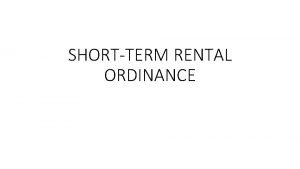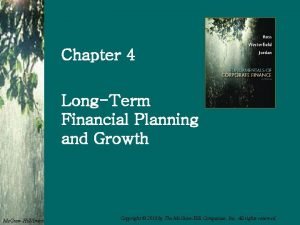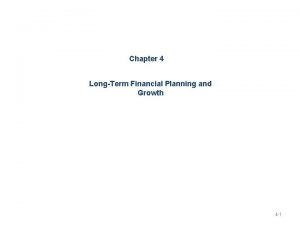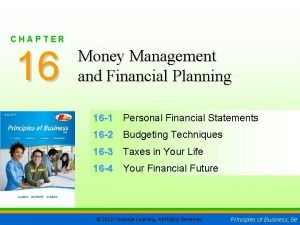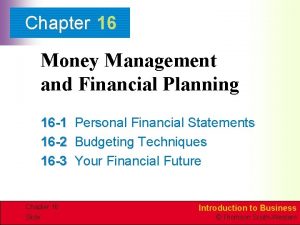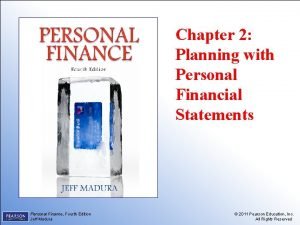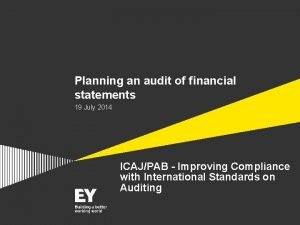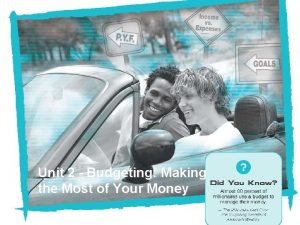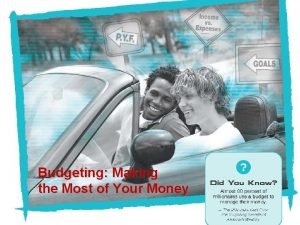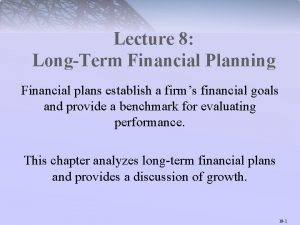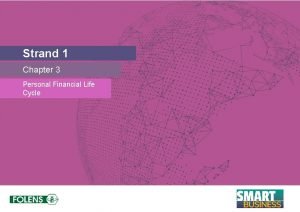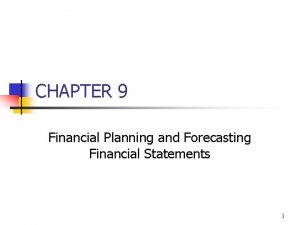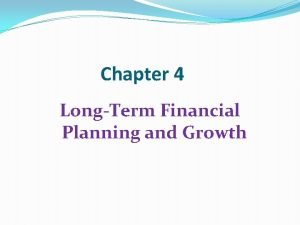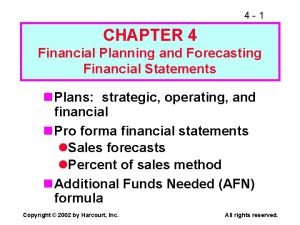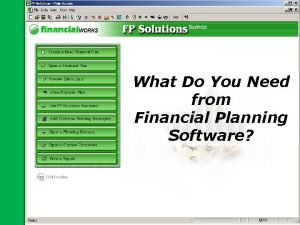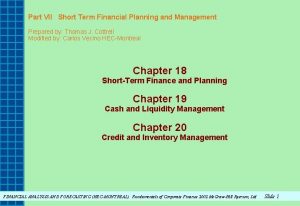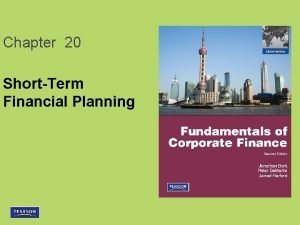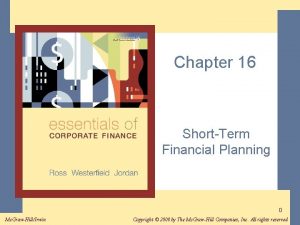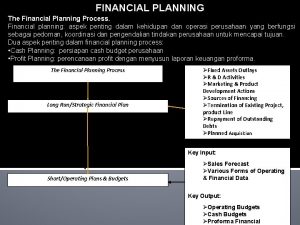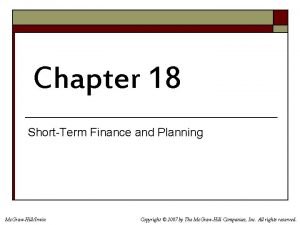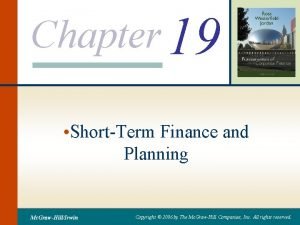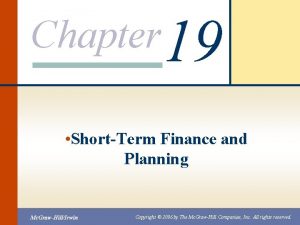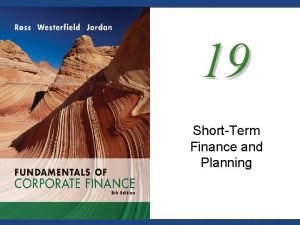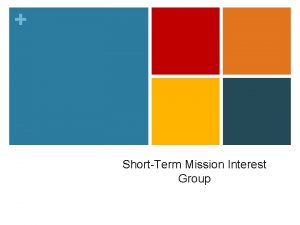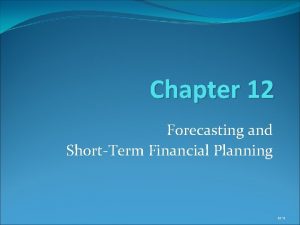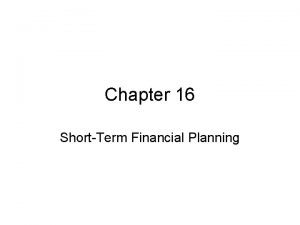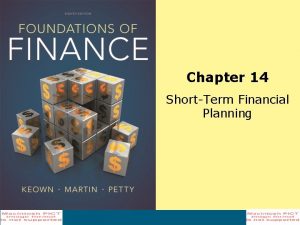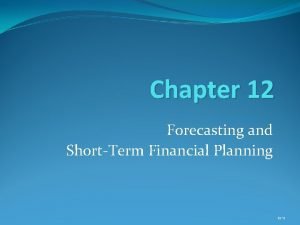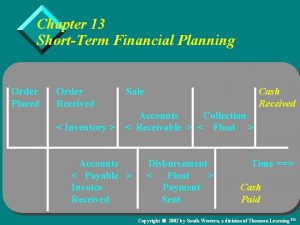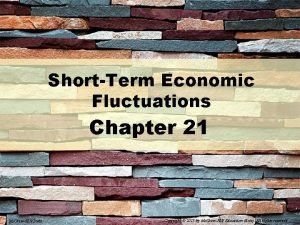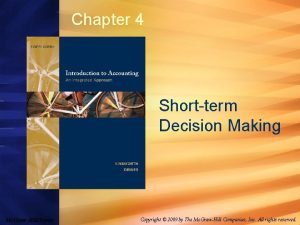ShortTerm Financial Planning Chapter 16 Mc GrawHillIrwin 2004
























- Slides: 24

Short-Term Financial Planning Chapter 16 Mc. Graw-Hill/Irwin © 2004 The Mc. Graw-Hill Companies, Inc. All rights reserved

Chapter Outline 1. 2. 3. 4. 5. 6. 7. Sources and Uses of Cash The Operating Cycle and Cash Cycle Calculate Operating Cycle and Cash Cycle Managers in Short-term Financing Short-Term Financial Policy Cash Budget Short-Term Borrowing 1 Mc. Graw-Hill/Irwin © 2004 The Mc. Graw-Hill Companies, Inc. All rights reserved

1. Sources and Uses of Cash n Sources of Cash n Obtaining financing: n n n Uses of Cash n Increase in long-term debt Increase in equity Increase in current liabilities n n Selling assets n n Decrease in current assets Decrease in fixed assets Paying creditors or stockholders n n Decrease in long-term debt Decrease in equity Decrease in current liabilities Buying assets n n Increase in current assets Increase in fixed assets Cash + Current Asset other than cash + Fixed Assets = Current Liabilities + Long-term debt + Equity 2 Mc. Graw-Hill/Irwin © 2004 The Mc. Graw-Hill Companies, Inc. All rights reserved

Sources and Uses of Cash Illustration Cash + Current Asset other than cash + Fixed Assets = Current Liabilities + Long-term debt + Equity 3 Mc. Graw-Hill/Irwin © 2004 The Mc. Graw-Hill Companies, Inc. All rights reserved

2. The Operating Cycle n The time it takes to receive inventory, sell it and collect on the receivables generated from the sale n Operating cycle = inventory period + accounts receivable period Inventory period = time inventory sits on the shelf n Accounts receivable period = time it takes to collect on receivables n 4 Mc. Graw-Hill/Irwin © 2004 The Mc. Graw-Hill Companies, Inc. All rights reserved

The Cash Cycle n The time between payment for inventory and receipt from the sale of inventory n Cash cycle = operating cycle – accounts payable period n Accounts payable period = time between receipt of inventory and payment for it n The cash cycle measures how long we need to finance inventory and receivables 5 Mc. Graw-Hill/Irwin © 2004 The Mc. Graw-Hill Companies, Inc. All rights reserved

Operating and Cash Cycle Illustration Inventory purchased Inventory sold Inventory period Accounts receivable period Accounts payable period Cash cycle Cash received Cash paid for inventory 30% 6 Mc. Graw-Hill/Irwin © 2004 The Mc. Graw-Hill Companies, Inc. All rights reserved

3. Example Information Item Beginning Ending Average Inventory 200, 000 300, 000 250, 000 Accounts Receivable 160, 000 200, 000 180, 000 75, 000 100, 000 87, 500 Accounts Payable Net Sales = $1, 150, 000 Cost of Goods Sold = $820, 000 7 Mc. Graw-Hill/Irwin © 2004 The Mc. Graw-Hill Companies, Inc. All rights reserved

Example - Operating Cycle n Inventory Period = 365 / Inventory Turnover n Inventory Turnover = COGS / Average inventory n IT n n = 820, 000 / 250, 000 = 3. 28 times Inventory Period = 365 / 3. 28 = 111 days Accounts Receivable Period = 365 / Receivables Turnover n Receivables Turnover = Credit Sales / Average AR n RT n n = 1, 150, 000 / 180, 000 = 6. 4 times Receivables Period = 365 / 6. 4 = 57 days Operating cycle = 111 + 57 = 168 days 8 Mc. Graw-Hill/Irwin © 2004 The Mc. Graw-Hill Companies, Inc. All rights reserved

Example - Cash Cycle Accounts Payables Period = 365 / payables turnover n Payables turnover = COGS / Average AP n PT = 820, 000 / 87, 500 = 9. 4 times n Accounts payables period = 365 / 9. 4 = 39 days n Cash cycle = 168 – 39 = 129 days n So, we have to finance our inventory and receivables for 129 days n 9 Mc. Graw-Hill/Irwin © 2004 The Mc. Graw-Hill Companies, Inc. All rights reserved

4. Managers in Short-term Financing 10 Mc. Graw-Hill/Irwin © 2004 The Mc. Graw-Hill Companies, Inc. All rights reserved

5. Short-Term Financial Policy n n n Flexible (Conservative) Policy n Large amounts of cash and marketable securities n Large amounts of inventory n Liberal credit policies (large accounts receivable) n Relatively low levels of short-term liabilities High liquidity Wants to avoid losing business because of shortage of resources n n n Restrictive (Aggressive) Policy n Low cash and marketable security balances n Low inventory levels n Little or no credit sales (low accounts receivable) n Relatively high levels of short-term liabilities Low liquidity Wants to avoid wasting resources 11 Mc. Graw-Hill/Irwin © 2004 The Mc. Graw-Hill Companies, Inc. All rights reserved

Carrying versus Shortage Costs Shortage costs (increase when current assets decrease) n Order costs – the cost of ordering additional inventory or transferring cash n Stock-out costs – the cost of lost sales due to lack of inventory, including lost customers n Carrying costs (increase when current assets increase) n Opportunity cost of owning current assets versus longterm assets that pay higher returns n Cost of storing larger amounts of inventory n 12 Mc. Graw-Hill/Irwin © 2004 The Mc. Graw-Hill Companies, Inc. All rights reserved

Choosing the Best Policy n Best policy will be a combination of flexible and restrictive policies n Compromise policy – borrow short-term to meet peak needs, maintain a cash reserve for emergencies 50% Mc. Graw-Hill/Irwin 13 © 2004 The Mc. Graw-Hill Companies, Inc. All rights reserved

6. Cash Budget n Primary n tool in short-run financial planning Identify when short-term financing may be required n How it works Identify sales and cash collections n Identify various cash outflows n Subtract outflows from inflows and determine investing and financing needs n 14 Mc. Graw-Hill/Irwin © 2004 The Mc. Graw-Hill Companies, Inc. All rights reserved

Example: Cash Budget Information n Expected Sales for 2005 by quarter (millions) n n n n n Q 1: $57; Q 2: $66; Q 3: $66; Q 4: $90 Beginning Accounts Receivable = $30 Average collection period = 30 days Purchases from suppliers = 50% of current quarter’s estimated sales, at the beginning of each quarter Accounts payable period = 45 days Wages, taxes and other expenses = 25% of sales Interest and dividends = $5 million per quarter Major expansion planned for quarter 2 costing $35 million Beginning cash balance = $5 million Minimum cash balance requirement = $2 million 15 Mc. Graw-Hill/Irwin © 2004 The Mc. Graw-Hill Companies, Inc. All rights reserved

Example: Cash Budget Step 1: Cash Collections Q 1 Q 2 Q 3 Q 4 Beginning Receivables 30 19 22 22 Sales 57 66 66 90 Cash Collections = Beg. Receivables + 2/3(Sales) 68 63 66 82 Ending Receivables = 1/3(Sales) 19 22 22 30 16 Mc. Graw-Hill/Irwin © 2004 The Mc. Graw-Hill Companies, Inc. All rights reserved

Example: Cash Budget Step 2: Cash Disbursements Payment of A/P = 50% of sales Wages, taxes, other expenses Capital Expenditures Long-term financing (interest and dividends) Total Disbursements Q 1 28. 50 Q 2 33. 00 Q 3 33. 00 Q 4 45. 00 14. 25 16. 50 22. 50 35. 00 47. 75 89. 50 54. 50 72. 50 75% 17 Mc. Graw-Hill/Irwin © 2004 The Mc. Graw-Hill Companies, Inc. All rights reserved

Example: Cash Budget Step 3: Net Cash Flow and Cash Balance Q 1 Q 2 Q 3 Q 4 Total Cash Collections 68. 00 63. 00 66. 00 82. 00 Total Cash Disbursements 47. 75 89. 50 54. 50 72. 50 Net Cash Flow 20. 25 (26. 50) 11. 50 9. 5 5. 00 25. 25 (1. 25) 10. 25 Net Cash Inflow 20. 25 (26. 50) 11. 50 9. 50 Ending Cash Balance 25. 25 (1. 25) 10. 25 19. 75 Minimum Cash Balance -2. 00 Cumulative surplus (deficit) 23. 25 (3. 25) 8. 25 17. 75 Beginning Cash Balance 18 Mc. Graw-Hill/Irwin © 2004 The Mc. Graw-Hill Companies, Inc. All rights reserved

Things to Consider in Cash Budgeting n Cash n reserve more important for firms with unexpected opportunities on a regular basis, less important for firms in stable business n Maturity n Avoid financing long-term assets with short-term securities n Relative n hedging interest rates Long-term rates are normally higher, you don’t want to rely on higher interest debt to finance temporary short-term assets 19 Mc. Graw-Hill/Irwin © 2004 The Mc. Graw-Hill Companies, Inc. All rights reserved

7. Short-Term Borrowing n Unsecured loans n n n Line of credit – prearranged agreement with a bank that allows the firm to borrow up to a certain amount on a short-term basis n Committed – formal legal arrangement that may require a commitment fee and generally has a floating interest rate n Non-committed – informal agreement with a bank that is similar to credit card debt for individuals Revolving credit – non-committed agreement with a longer time between evaluations Secured loans – loan secured by receivables or 20 inventory or both Mc. Graw-Hill/Irwin © 2004 The Mc. Graw-Hill Companies, Inc. All rights reserved

Short-Term Financial Plan Q 1 Q 2 Q 3 Q 4 Beginning Cash 5. 00 25. 25 2. 00 10. 05 Net Cash Inflow 20. 25 (26. 50) 11. 50 9. 50 New Short-Term Debt 0. 00 3. 25 0. 00 Interest on Short-Term Debt 0. 00 0. 20 0. 00 Short-Term Debt Repayment 0. 00 3. 25 0. 00 Ending Cash Balance 25. 25 2. 00 10. 05 19. 55 Minimum Cash Balance -2. 00 Cumulative Surplus (Deficit) 23. 25 0. 00 8. 05 17. 55 Beginning Short-Term Debt 0. 00 3. 25 0. 00 Change in Short-Term Debt 0. 00 3. 25 -3. 25 0. 00 Ending Short-Term Debt 0. 00 3. 25 0. 00 21 Mc. Graw-Hill/Irwin © 2004 The Mc. Graw-Hill Companies, Inc. All rights reserved

Review Questions 1. What kind of activity is a source of cash and what kind of activity is a use of cash? 2. What is operating cycle? What is cash cycle? How cash cycle will be affected by changes in inventory period/turnover, accounts receivable period/turnover, and accounts payable period/turnover? 3. Know how to calculate operating cycle and cash cycle given information on sales, COGS, inventory, account receivable, and account payable. 22 Mc. Graw-Hill/Irwin © 2004 The Mc. Graw-Hill Companies, Inc. All rights reserved

Review Questions (cont. . ) 5. What are the differences between flexible and restrictive short-term financial policies? What are carrying costs and shortage costs? 7. What are the short-term borrowing options? 23 Mc. Graw-Hill/Irwin 100% © 2004 The Mc. Graw-Hill Companies, Inc. All rights reserved
 #shortterm
#shortterm Shortterm housing
Shortterm housing Chapter 4 financial decisions and planning
Chapter 4 financial decisions and planning Chapter 4 financial decisions and planning
Chapter 4 financial decisions and planning Chapter 10 financial planning with life insurance
Chapter 10 financial planning with life insurance Long term financial planning and growth chapter 4
Long term financial planning and growth chapter 4 Sustainable growth rate
Sustainable growth rate Chapter 16 money management and financial planning
Chapter 16 money management and financial planning Chapter 16 money management and financial planning
Chapter 16 money management and financial planning Chapter 2 personal financial planning answers
Chapter 2 personal financial planning answers Chapter 4 financial decisions and planning
Chapter 4 financial decisions and planning Chapter 4 financial decisions and planning
Chapter 4 financial decisions and planning Chapter 4 financial decisions and planning
Chapter 4 financial decisions and planning Non financial methods of motivation
Non financial methods of motivation Benefits of audit planning isa 300
Benefits of audit planning isa 300 Personal financial planning life cycle
Personal financial planning life cycle High school financial planning program answer key
High school financial planning program answer key Nefe high school financial planning program answer key
Nefe high school financial planning program answer key Long term financial planning model
Long term financial planning model Financial life cycle stages
Financial life cycle stages Financial planning and forecasting
Financial planning and forecasting Long term financial planning process
Long term financial planning process Financial planning and forecasting
Financial planning and forecasting Fp solutions financial planning software
Fp solutions financial planning software Long term financial planning
Long term financial planning

